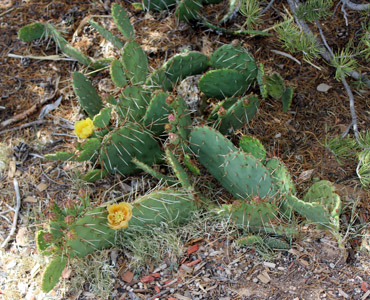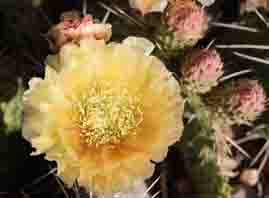The Plant w/Flowers

The Flower

Description
"The plant forms low, spreading clusters, 2 to 3 feet high, of oval or nearly circular stems, bearing clusters of 8 or fewer white or brown central spines, between 1 and 3 inches in length and quite thick, so longer and more substantial than some comparable species. Areoles towards the base of the pad often have no spines; sometimes spines are found only at the areoles on the uppermost quarter of the pad. During dry periods the dark green pads (which can be up to 9 inches long) may take on a purplish tinge along the tips.
Central spines point outwards or downwards, while the 1 to 3 lower (abaxial) spines always point downwards, and are much shorter, generally less than half an inch. Opuntia polyacantha is another similar species, but this generally has more spines per areole, and is less likely to have areoles with no spines.
Flowers appear in spring and early summer, and are also variable in color; they may be lemon yellow, orange or pink, usually with but sometimes without a reddish center. The fruits are reddish purple." (The American Southwest)
Ethnobotanical Uses
Food:
"Prickly-pear cacti were widely used for food, though the fruits of these species are smaller and less fleshy than those of their southern relatives. The flavor ranges from bland to sweet to sour and has been likened (at best) to sweet pomegranates. Spines were peeled off, burned or, picked off (with fingers protected by deerskin tips), or removed by sweeping piles of fruit with sagebrush branches. The fruits were then split to remove the seeds and eaten raw (alone or with other fruits), cooked in stews and soups as a thickener, or dried for later use. --- Dried seeds were added to soups and stews or were ground into flour and used as a thickener. Raw cactus stems have been likened to cucumber, but they were usually eaten only when there was a shortage of food. Young segments were boiled and peeled to remove their spines, and the pulpy flesh was fried. Cactus stems have also been pickled or candied."(Kershaw 142-3)
"To enjoy the so-called Indian fig, cut off the ends of these fruits of the prickly pear, slice the hide lengthwise, and scoop out the pulp. Either that, or peel them. A few species, though, are smooth, while others are covered only with bristles that can be easily scraped away as with a bunched handfull of grass. Pleasant raw, the ripe fruit can also be turned into candy or jelly.
The dried seeds are sometimes ground into flour or used to thicken soups. The newer, tenderer pads in particular are sweetly edible once they have been despined when necessary. Sliced, boiled, or roasted, and seasoned, they have proved to be valuable greens in lean times. Although this can be further cooked until it is a rich, dark, highly nutritious paste, some say it is at its best while still a sauce if first allowed to ferment slightly. They also make an interesting pickle.
A bitterish and somewhat sticky juice can be pressed or sucked from the insides of these prickly pear stems and used as emergency water." (Angier 178)
Recipe 1: Grilled Nopale Salsa
(To harvest the fruit or pad, use a sharp knife and make a clean slice about 1" above where it attached to the pad below. Carefully peel the outer layer off the fleshy interior by making one cut down the length and then removing strips of skin with a sharp knife. It is advisable to wear thick protective gloves. To harvest the pads you must remove the small spines, or glochids. The skin can be stripped or left on. Spines can also be scrubbed off with a stiff brush, burned off, or rolled in sand to remove.)
"Remove prickly skins as directed above. Lightly coat inner flesh with oil. Grill gently until just browned. Remove from heat and dice. Combine with equal parts diced, raw tomatoes. Add chopped onion, chopped garlic, and plenty of fresh-squeezed lime juice. Salt and pepper to taste. Serve with grilled chicken or organic corn chips." (Morgan 135)
Recipe 2: Tuna Fruit Salad (the fruit are sometimes called tuna)
"Prepare fruit by stripping the skin as described above. Cut into quarters or, if very large fruits, bite-size pieces. Prepare 2 cups of the cactus fruit. Prepare 1 cup sliced bananas. Squeeze fresh lime juice over the bananas, and toss together gently. Slice enough peaches to make 1 cup. Combine all fruit, and toss gently. Top with pine nuts; serve at room temperature." (Morgan 135)
Recipe 3: Prickly Pear Juice
"Harvest several fruits. Slice them in half. Using a spoon, remove the seeds and then scoop out the fleshy centers. Place 2 cups fruit in a blender with 1 cup water. Blend on medium speed until pulverized. Enjoy as is, or combine with sparkling water to make a spritzer" (Morgan 136)
Medicine:
"The peeled mucilaginous stems were used for dressing wounds or were mashed and placed on aching backs. Stems were also boiled to make a medicinal drink for relieving diarrhea and lung problems and for treating people who could not urinate.
Split stems were placed in containers of muddy water, where they exuded large amounts of mucilage, which cleared the water and made it drinkable.
Freshly peeled stems were sometimes rubbed over painted hides to fix the colors." (Kershaw 142-3)
Other Uses:
"--- at Zuni (Pueblo) the prickly pear fruit may be dried, ground, and dissolved in water with a chunk of dried beeplant to make dye. The mixture creates a reddish shoe polishlike substance that has been used on moccasins. This same prickly pear beeplant combination has also been used to dye thread or weaving fiber." (Dunmire and Tierney 190)